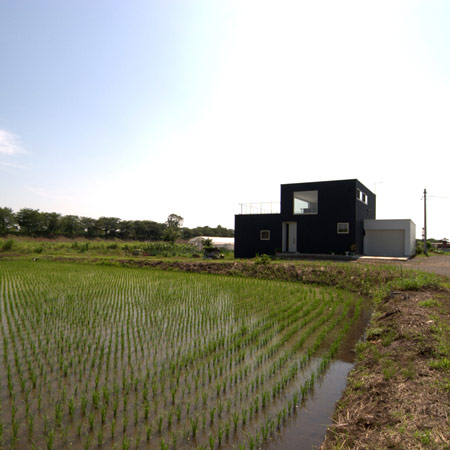
With by Studio Loop
Japanese architects Studio Loop have completed a house in Gunma, Japan, conceived as a hole in which the residents can shelter.
Called With, the two-storey house is situated with a main road to the north and farmland to the east and west.
Private rooms are located on the ground floor, organised around the perimeter of a double-height communal space.
The upper level overlooks the surrounding fields and cherry trees, and includes access to a terrace.
Here are some more details from Studio Loop:
--
In past 60 years, as information technology progressively changed, in Japan, our housing industry has rapidly adjusted to it. This “forced adjustment” to our society has caused a transformation of our traditional lifestyle, and housing space has been often talked by “nLDK” ; n (number of private rooms) L (living) D (dining) K (kitchen). The concept of nLDK is to describe how much value your house has. The spatial flexibility and relationship (private and public) among n, L, D, and K are separated and lost, and as a result, “function” started to walk alone.
Our proposals are to try to re-consider and re-organize a quality of relationship of nLDK to re-adjust to a current and a future lifestyle.
Located on a rural area in Gunma, Japan, this site is surrounded by a particular environment, busy traffic on north, big flat farm garden on west and east, and long line of tree of cherry blossom on south.
The climate here is also unusual. In summer, this town records the hottest temperature every year, and in winter, a strong gust wind from north and west blows into this area. To live with this severe environment, young client family requested not only typical ones, which are privacy, lot of natural light, good ventilation, and but also the place where a family can feel being protected, sensitivity and motion.
Beginning with this keywords and programs they gave us, our solution to the house started to form.
First, we imaged “a surrounded big hole” inside of a house as LDK. Originally, primitive human habited in a hole (cave) because they have to protect themselves from a hazardous enemy and environment. It’s not exactly similar to what primitive human had, but to live in the hole (cave) was inevitable to our progress of habitation. So, we used this “hole” idea as a direction of a solution to initiate our design process.
The 5m double volume hole (LDK) exists as a family can share all activities such as cooking, eating, playing, studying, and even running. Opposite to the hole (LDK) placed in the center body of a house, private room zone (master bedroom and kid’s bedroom) and service room zone (bathroom, toilet, and storage) are placed 600mm below LDK, and they surround the hole (LDK) and act as a buffer zone between outside and LDK to stabilize their day life from seasonal severe weather and traffic noise.
In addition, because private rooms, service rooms and LDK are directly connected by just opening doors, a family can easily access to each room and air ventilation that is one of the important factors to this house can go through whole spaces.
Library space, planting space, study space, and DJ space in the second floor are connected to the double volume LDK space with no wall, creating a unity of space and family activities.
Another main character of this house is the 2m x 5m fix high window placed in the upper level. It gives a view to the sky from LDK down stair, and also strengthens the sensitivity of being in the hole that makes a family to be protected. Surely it provides an enough natural light even cloudy weather. In spring, this window becomes a picture frame of cherry blossom trees that are one of the Japanese traditional trees. In summer time, the corridor in upper level becomes an eave to protect from a direct sunlight, and in winter time, sun can penetrate into the kitchen to warm up LDK space.
Over the window, there is a terrace where a family can enjoy talking, playing, taking a break, and eating BBQ with friends.
Since we had to find a solution at low cost budget, an exterior skin had to be one material. Considered to its natural landscape, we thought the house should be a mass and a unity object and chose black which makes its existence disappear in the natural environment. To do this, we wanted to reflect the form against nature. In the suburban area, opposite to the urban area like Tokyo, people have a lot of opportunities to have a relationship to nature everyday. Here we started to design how a house can keep standing against particular environment.
Project Name: With
Project Year: 2008-2009
Location: Itakura town, Gunma, Japan
Program: Residential
Structure: Wood Construction
Site Area: 413.13 sqm
Building Area: 133.32 sqm
Total Floor Area: 173.07 sqm